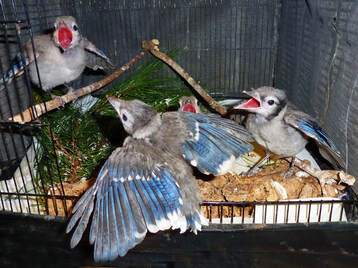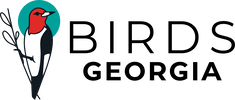 Blue Jays, by Diana Churchill. Blue Jays, by Diana Churchill. By Diana Churchill, Ogeechee Audubon Society I first met Pat Wolters in 2001 while working at Wild Birds Unlimited. A petite, energetic woman of 71 years came into the shop to buy food and feeders to support her passion for tending the wild birds in her new backyard on Skidaway Island. Pat and her husband, Art, had just relocated to Savannah from Delaware. In 1989, while living in Maryland, Pat had taken her love of birds to a new level by becoming a volunteer at Tri-State Bird Rescue and Research in Newark, Delaware. Her first job was doing the laundry, but she quickly moved on to other tasks, serving as Banding Chairperson, Release Chairperson, and a member of the Oil Spill Core Team. After she moved to Savannah, Pat looked for similar volunteer opportunities and found that Savannah had almost no resources for bird and wildlife rescue. While Pat worked part-time at Wild Birds Unlimited, she was surprised by the number of people who walked into the shop with birds in a shoebox. She realized she needed to obtain the permits required to operate as a licensed rehabilitator. Even though she intended to focus on birds, permitting from the Georgia Department of Natural Resources and the U.S. Fish & Wildlife Service required that Pat study all the materials about mammals, too, and pass a 100 question /1-hour timed test. The other requirement to earn her permit was to accrue a certain number of hours as a volunteer at an existing facility. She and Nicole Janke, the manager of Wild Birds Unlimited, began making weekly trips to McIntosh County to work with Emmy Minor at Sanctuary on the Sapelo. After Pat received her permits and started Orphaned Bird Care, Nicole became her assistant and chief volunteer. Working with both of them at Wild Birds Unlimited, I’ve had a chance to observe first-hand all the joys, challenges, and heartache that go along with a commitment to helping birds. For starters, helping birds takes more than knowledge and a permit. You need food to feed them, baskets and cages to house them, and medicines to treat them. All of this takes money. Pat is fortunate to receive grants from Ogeechee Audubon, Skidaway Audubon, The Landings Garden Club, the Landings Landlovers, and the Green Thumb Garden Club, as well as donations from individuals. If you find a bird and bring it to a rehabilitator, please consider making a donation, no matter how small. Pat’s permit requires that a veterinarian must see injured birds. There are only a handful of vets who have the necessary licenses and the willingness to treat wild animals, usually pro bono. Through the years, Pat and Nicole have been fortunate to have the help of a number of vets, including Dr. Chris Gall, Dr. Leslie Mailler, and Dr. Stacy Wilkinson. I went out to Pat’s house in early April to get a tour of her “facilities.” Nesting season had just gotten underway so the basket on the desk in her half of the office she shares with Art was empty. It has a heating pad on the bottom, covered with a towel, a small soft substitute “nest bowl,” a mirror, a branch perch, and an elastic-edged fabric screen cover. More than likely, by the time this article appears in print, the basket will house a family of hungry babies, needing to be fed at least every hour. Thankfully, the birds do not have to be fed at night. The “season” will begin with a phone call, a story, and then a handful of gaping mouths to be fed. Nicole will walk into the shop one day with her basket, announcing, “I have dependents.” The resident wrens, chickadees, bluebirds, nuthatches, woodpeckers and doves will come first, followed later by the migratory warblers, great crested flycatchers, eastern kingbirds, green herons, and chimney swifts. Early on, Pat and Nicole developed a kind of job-sharing for tending baby birds. Nicole takes on many of the tiny nestlings that can easily be confined in baskets. When they get too big and active to be happy in a basket, they move to a cage, often at Pat’s nursery. During the height of the season, the two may be tending as many as 60 to 70 nestling and fledgling birds. Indoors, in her bird room, Pat has two cages, baskets, and an incubator. In the garage she has three large cages on wheels that can be moved outside during the day. They are not predator proof so must be returned to the garage at night. She also has an outdoor aviary designed by her architect son, and built with money from a Landlovers grant. Both Pat and Nicole have a variety of feeders, birdhouses, and watering stations outside in their yards, to take care of the local birds as well as the special birds they care for and release. Orphaned Bird Care also focuses on education. Not all baby birds need to be rescued. Parent birds can be very quick about the task of bringing in the bugs, so unless you spend thirty minutes or more watching, you might mistakenly assume that the babies are not being fed. Helpless nestlings do need to be fed and tended, and take well to being fed by humans. Fully feathered fledglings, on the other hand, are out of the nest naturally. Their parents care for them, and teach them what they need to know to survive as a bird in a perilous world. Fledglings, when “rescued,” do not take well to being fed by humans and are deprived of that period of essential learning. When I asked Pat to tell me about one of her favorite bird friends, she immediately mentioned a pileated woodpecker. I happened to be at the shop the day a man showed up with two young woodpeckers that came from the cavity of a tree that had been cut down at Hunter Army Airfield. One bird had sustained serious injuries in the fall and did not make it, but the other grew and thrived. Nicknamed “Big Red,” Pat eventually released him in her yard. He returned frequently that first year, coming to a particular tree to get his supplemental snacks, until he found a mate. Nicole and Pat treat over 340 native birds annually. Eighty percent of the birds they care for are released back into the wild. For more information, visit Pat’s web site at www.orphanedbirdcare.com.
1 Comment
Cathy A Cortright
7/14/2021 09:02:03 am
What a great story!!
Reply
Your comment will be posted after it is approved.
Leave a Reply. |
AuthorBirds Georgia is building places where birds and people thrive. Archives
April 2024
Categories |

 RSS Feed
RSS Feed

